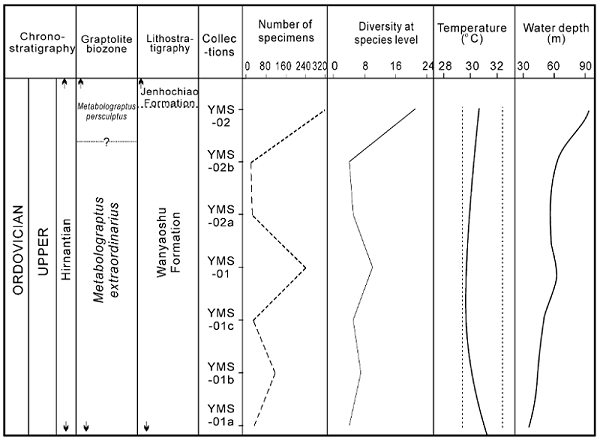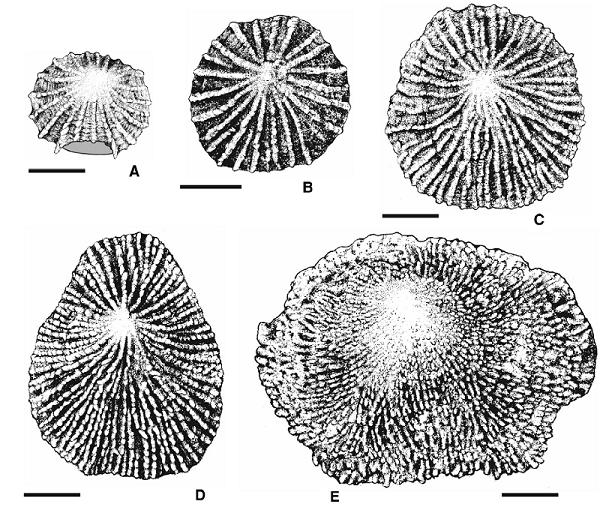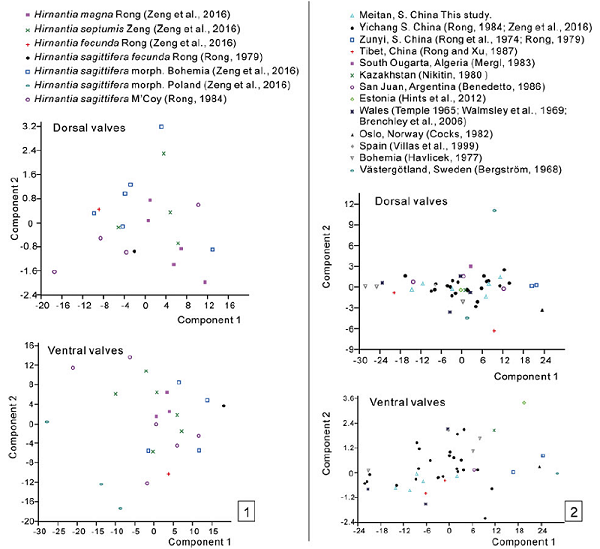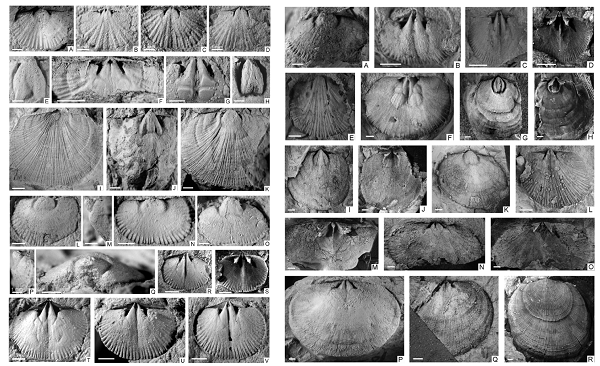Between two phases of the Late Ordovician mass extinction, Hirnantia Fauna developed globally, and world widely reported except that from Sibumasu Terrane, which now consists of Myanmar, peninsular Malaysia, western Thailand, Sumatra and parts of western Yunnan of China. The Terrane is geographically important, however, the features of Hirnantia Fauna from which and its relationship to South China have long been unclear. Since Reed firstly reported fossils from northern Shan State, Myanmar in 1915, there has been only one relevant paper (with only 9 brachiopods), and the information about western Yunnan is only recorded in one abstract.
Recently, Academician RONG Jiayu, Prof. ZHAN Renbin, Prof. HUANG Bing and CHEN Di (RA) from Nanjing Institute of Geology and Palaeontology, Chinese Academy of Sciences, collaborated with Dr. Kyi Pyar Aung from Taunggyi University, Myanmar and Prof. David Harper from Durham University, Britain, studied Hirnantia Faunas from Hwe Mawng purple shale Member, Naungkangyi Group, Mandalay of Myanmar, Wanyaoshu Formation, Mangshi of western Yunnan, and Kuanyinqiao Bed, Meitan, of Guizhou (South China). A series of papers have been published, with 23 genera and 23 species of brachiopods from Mandalay, Myanmar, 22 species of 22 genera from western Yunnan, and 13 species of 13 genera from northern Guizhou were identified. Among them, Hirnantia itself was recorded from Myanmar for the first time, and a new systematical argument to some key taxa was put forward. In addition, Xenocrania, a new genus of Craniid brachiopod was established, and the synonyms for some core taxa of the fauna were revised. These systematic works provide a real basis for global summary in the future. More importantly, based on the classification information, with data from global relevant literatures and fossil materials, the studies revealed some facts in paleobiogeography, community ecology, and population ecology and variation as follows.
Paleobiogeography:
Based on the comparison of common and core taxa of the Hirnantia Fauna in Sibumasu Terrane and South China, the network analysis method is adopted to prove close relationship between them. The comparative study of Hirnantia Faunas from the Sibumasu Terrane and its adjacent blocks shows that the former was not far away from the south China plate and the Lhasa terrains, and they were all in the shallow tropical waters during the latest Ordovician. The Hirnantia Faunas from Sibumasu and South China with such a high diversity at the end of the Ordovician are very rare, shows their global importance. Brachiopod studies revealed the complex climatic differentiation from low latitude to high latitude during global cooling process in the late Ordovician. The origin and extinction of this global benthic fauna dominated by opportunistic is the important signal of the first and second phases of the major event respectively.
Community ecology:
The kinella-Paromalomena Association, which lived in deeper water (lower part of BA3, closer to BA4), was recognized based on the information of bathymetric indicator taxa together with data of both diversity and abundance of the Hirnantia Fauna in the Mandalay Division, Myanmar. However, The Hirnantia-Eostropheodonta Association in Meitan, Guizhou province lived in a relatively shallow water environment (BA2 to upper part of BA3). These two assemblages showed obvious differences in many features, as key taxa, composition and diversity. The materials in western Yunnan collected from the Wanshuyao Formation, which was significantly thicker than most of the Kuanyinqiao bed. Studies on brachiopods from 7 bottom up layers, two sets of associations (both including key taxa of Hirnantia Fauna, such as Hirnantia), the Fardenia-Hirnantia association (lower) and the Aegiromena-Anisopleurella association (upper). They belong to the typical shallow-water and deep-water Hirnantia Fauna respectively. There were significant differences in diversity, abundance and body size distribution between the two associations. The ecological succession of community from shallow water to deep water reflected the complexity and evolution of global glacial climate and Marine environment. The deglaciation process of the second pulse of the end-Ordovician mass extinction, was confirmed by the succession of brachiopod community.
Population ecology and variation:
Hirnantia, nominated the Fauna, is the most important taxon in the Hirnantia fauna, but its species assignment has been controversial. Based ondata from South China and other regions in the world for H. sagittifera, the type species of the genus from representative, the measurements and statistics of the key characters confirmed the significant and extensive variation in H. sagittifera. Six species (including two morpho-types) published previously were all proved to be the synonym of H. sagittifera.
Based on materials difficult to identify from Myanmar, South China and other regions, a new genus Xenocrania was established, with its type species Palaeocyclus? haimei Reed (originally described as a coral) from the Hirnantia Fauna in northern Shan State, Myanmar. They found drastic variation of ornamentation of this genus. Three types of ornamentation are recognized within the same population of this species, and even on the same individual. This significant phenotypic pleiotropy was considered may be the response to the strong ecological pressure during the bio-event, in order to improve its probability of survival from the deteriorating environment.
Financial supports for this work were provided by the Strategic Priority Research Program of Chinese Academy of Sciences, and the National Natural Science Foundation of China. The research results have been published recently in the journals Palaeoworld, Papers in Palaeontology, Journal of Paleontology, Lethaia and others.
Publications information:
Rong Jiayu, Aung K P, Zhan Renbin, Huang Bing, Harper D A T, Chen Di, Zhou Hanghang, Zhang Xiaole, 2020. The latest Ordovician Hirnantia brachiopod Fauna of Myanmar: Significance of new data from the Mandalay Region. Palaeoworld, 29: 1–30.
Huang Bing, Zhou Hanghang, Harper D.A.T., Zhan Renbin, Zhang Xiaole, Chen Di, Rong Jiayu. 2020a. A latest Ordovician Hirnantia brachiopod fauna from western Yunnan, Southwest China and its paleobiogeographic significance. Palaeoworld, 29: 31–46.
Huang Bing, Rong Jiayu, Harper D.A.T., Zhou Hanghang. 2020b. A nearshore Hirnantian brachiopod fauna from South China and its ecological significance. Journal of Paleontology, 94(2): 239–254.
Huang Bing, Harper D.A.T., Zhou Hanghang, Rong Jiayu. 2020c. From shallow to deep-water: an ecological study of the Hirnantia brachiopod Fauna (Late Ordovician) and its global implications. Lethaia, doi.org/10.1111/LET.12360.
Chen Di,Rong Jiayu. 2019. A new craniid brachiopod genus from the terminal Ordovician Hirnantia fauna of Myanmar and South China. Papers in Palaeontology, 5(3): 521-535.

Fig. 1. Paleogeographic map displaying the positions of Sibumasu Terrane and other blocks; Network Analysis for Hirnantia Fauna demonstrates the close relationship between these blocks

Fig. 2. Diversity and abundance curves for the Hirnantia Fauna from western Yunnan

Fig. 3. Phenotypic pleiotropy of new genus Xenocrania, all are the same species

Fig. 4. PCA shows significant variation of the type species of Hirnantia; 6 species were revised

Fig. 5. Representative brachiopods of the Hirnantia Fauna of Myanmar (left) and western Yunnan (right)
